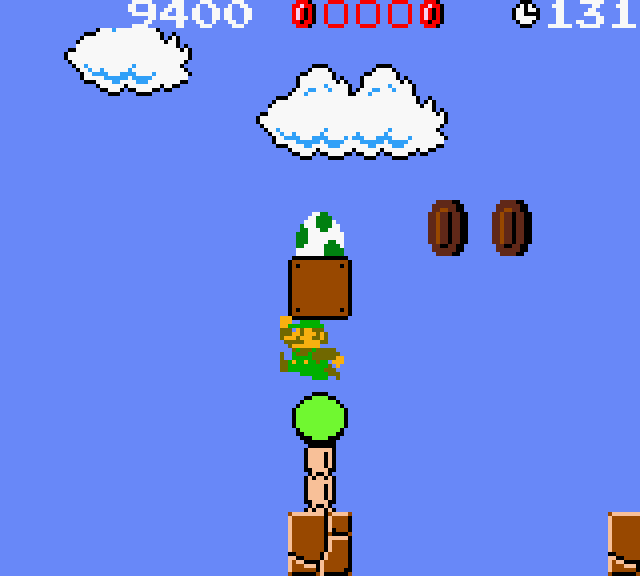24. World 3-4
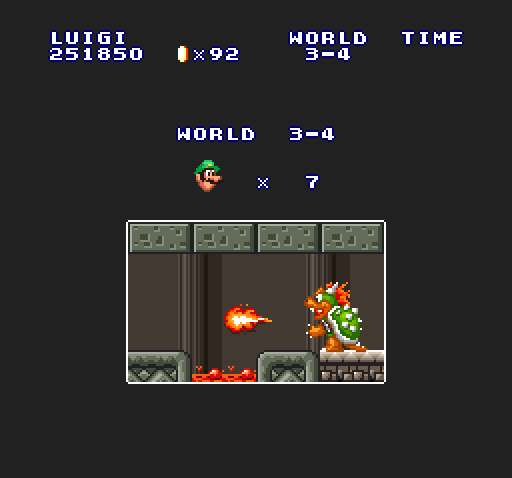
3-4 may not be a true copy, but many o’ its elements are very similar to those found in 1-4 & 2-4, but with setpieces repeated extra times to make it a li’l harder.
We get that in its strongest form @ the beginning, where we’re hit with 3 copies o’ the same 3-block-wide platform from the beginning o’ 1-4, not e’en @ different heights like 2-4’s platfors, all with the same firebar going the same direction @ the same speed. But ’stead o’ a ?-block o’er any o’ these platforms, we just have Podoboos jumping up & down in the surrounding lava, which could look somewhat like a mix o’ what 1-4 & 2-4 started with if you squint hard ’nough @ it; but since these elements are so common, & are combined several other times, too, it’s hard to get much interest out o’ them. I s’pose it does add extra challenge in that you can’t just wait fore’er for Podoboos to be in just the right place before jumping while the firebar clock is ticking toward you. 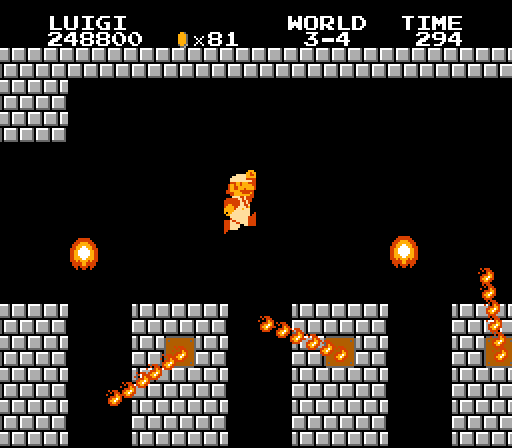
Next we have the same kind o’ firebar jumps players did in 1-4, but now a block higher & all the harder version with 2 firebars per block, the final pair differing only in their relative position & timing, adding the slightest extra challenge. 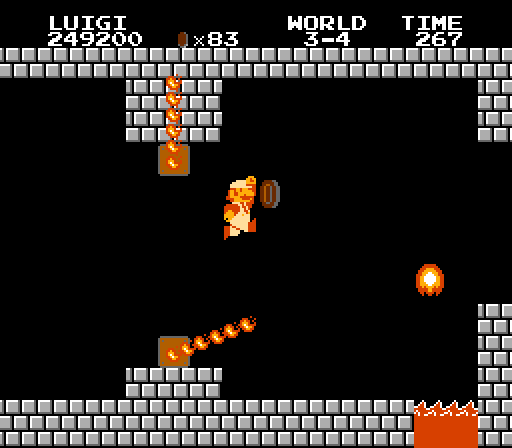
The only setpiece worth talking ’bout is the 3-?-block formation with a power-up in the middle, which, if you release a mushroom, it can be easy to drop it into the lava. The same setpiece will be repeated soon in 4-2, tho, so e’en that doesn’t help this level feel in any way unique or vital to this game. 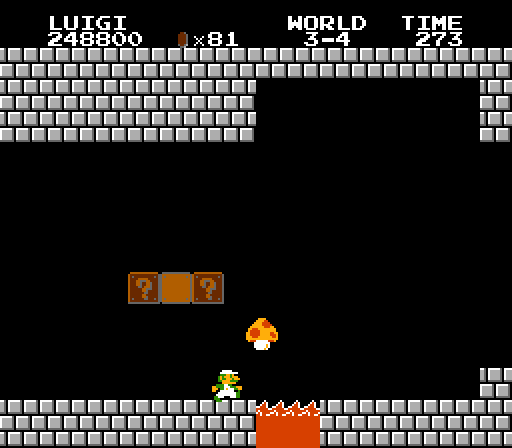
That said, the red coins are all in great locations, requiring precise high jumps off the edge o’ firebar-manned steps & low jumps o’er lava. 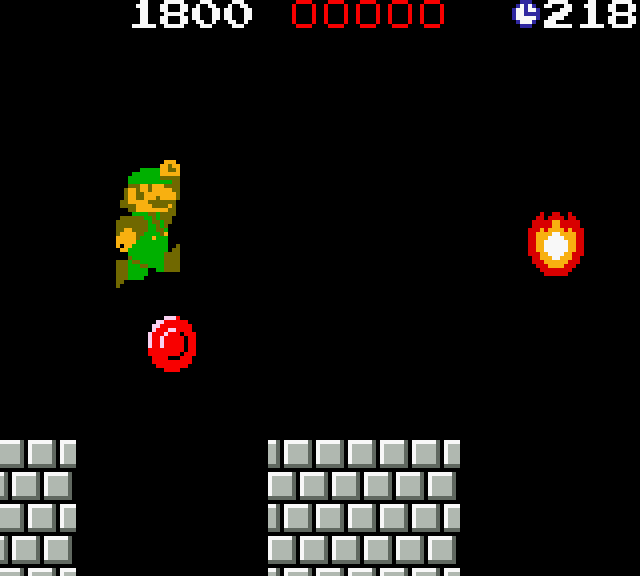
The Yoshi egg’s location feels arbitrary, tho: it’s just ’mong a bunch o’ invisible blocks in a wide-open empty space that’s hard to discern from the rest o’ the level. 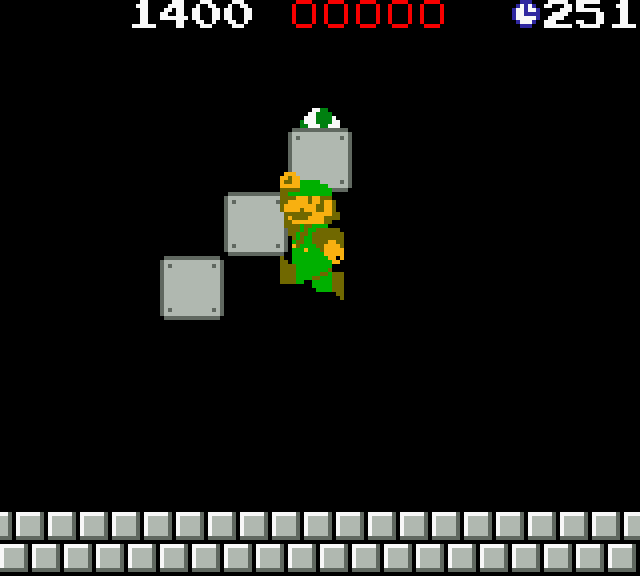
23. World 2-4
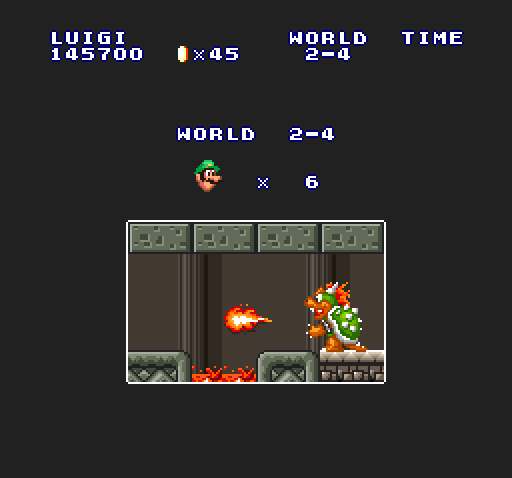
The very 1st section that introduces Podoboos is much weaker than the 1st section that introduced firebars in 1-4. Maybe it would’ve been too trollish to put a Podoboo under the ?-block ( in fact, here I should admit that, in general, Podoboos are much weaker enemies than firebars, acting as just a place to wait for when it’s safe to pass thru, whereas firebars can a’least be placed in tricky arrangements ), but they could’ve done something mo’ interesting than just 3 platforms, 2 Podoboos @ the edges, & a ?-block in the middle. 5-4, ’course, puts a firebar there to add difficulty; but why they need to wait several worlds later to add difficulty in a way that the previous castle did is a mystery to me. 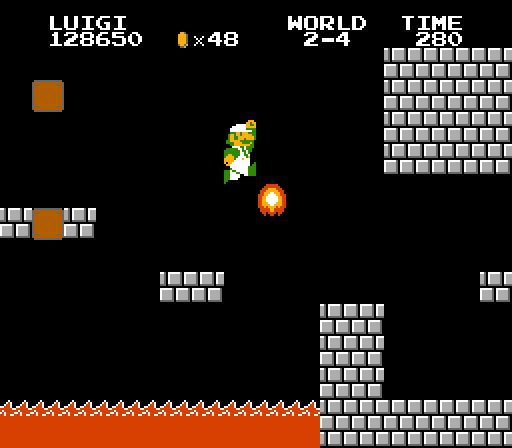
The useless firebar hall in 1-4 has now been split into 2 wherein the player has to estimate which path is safest, with the missing firebar @ the beginning telegraphing the bottom hallway as the safest. While the top hallway forces the player to wait round mo’ for the firebars to get out o’ your way, the bottom is essentially the equivalent to the hall in 1-4. On 1 hand, giving the player a split path is a li’l mo’ interesting; on the other, making the only alternative to 1-4’s straight run thru be the “challenge” o’ waiting mo’ is less fun. 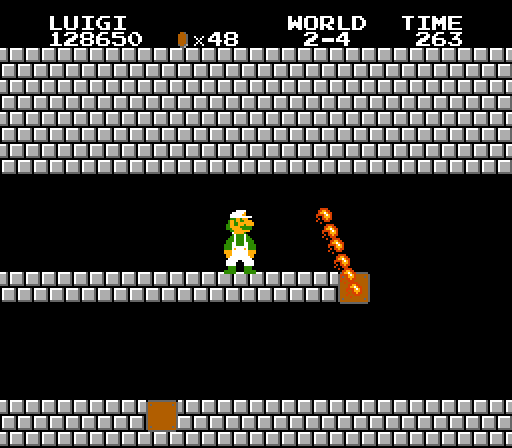
The strongest part is the following elevator section, which is, if anything, perhaps too hard for this early in the game, specially the part just after it with a firebar &, most likely, 1 o’ Bowser’s flame taking up the only other formerly safe space. I would’ve left the firebar out in the earlier 2-4 version to better balance this castle level & add variety ’tween this & its twin, 5-4. 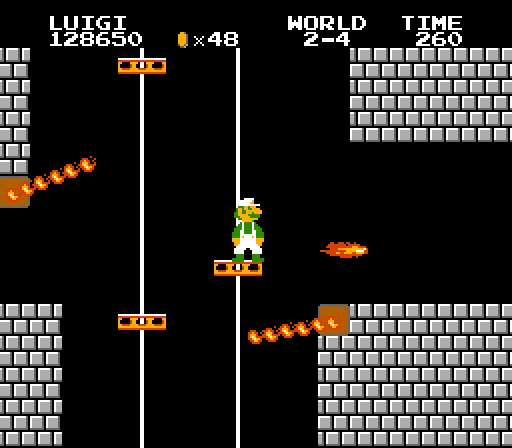
In contrast to this, after that is some pointless section with a block just sitting there, which is obviously just there ’cause it will have a firebar in the inevitable harder copy later. I would say that keeping the firebar here would’ve been mo’ useful than the previous, but e’en with the firebar it’s not an interesting setpiece, so it would’ve been better to just leave out this section in both versions entirely. 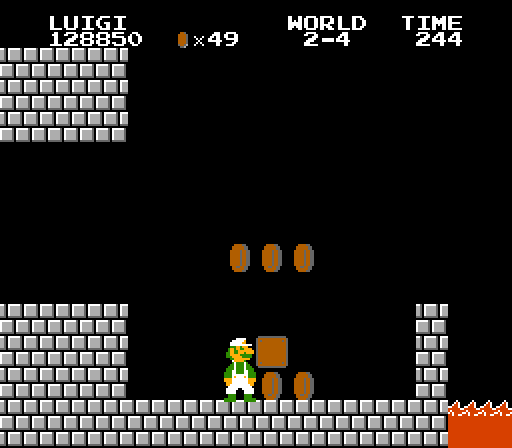
It’s odd that they start the ending gauntlet with jumps o’er lava & then make things easier by changing to jumps o’er safe ground. 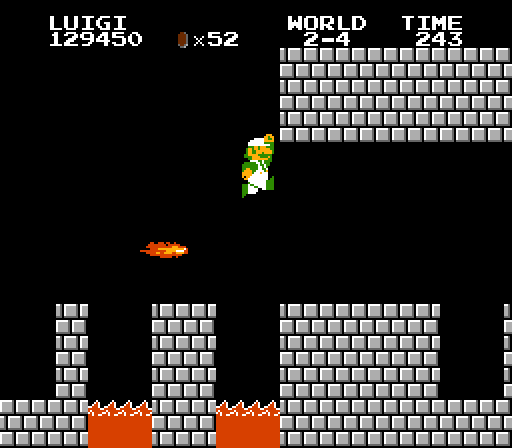
I also question why they gave so li’l space round the platform ’bove Bowser in such an early level. 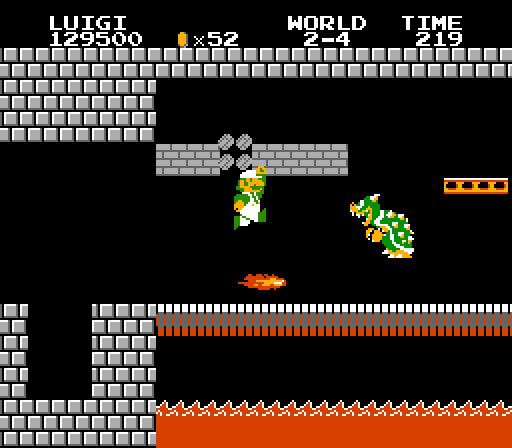
This level is a mix o’ setpieces too simple & too challenging for such a level & most o’ it feels like dead space & repeating setpieces so recently experienced in 1-4. A big problem with this level is it feels like too much o’ it is just setting up the added twists in its harder clone, 5-4, than being its own level. The elevator section almost made me rank it higher than 1-4, but 1-4’s strong start & middle are worth mo’ than it, so like Phil Leotardo, I compromised & put it ’tween 6-4 & 1-4.
The red coin locations aren’t too bad, ’cept the 2nd ( tho part o’ me’s glad they didn’t make it so that you had to take a certain path during the fork to get it ). I particularly like the 1 up in the elevators, making, well, elevating actually useful. 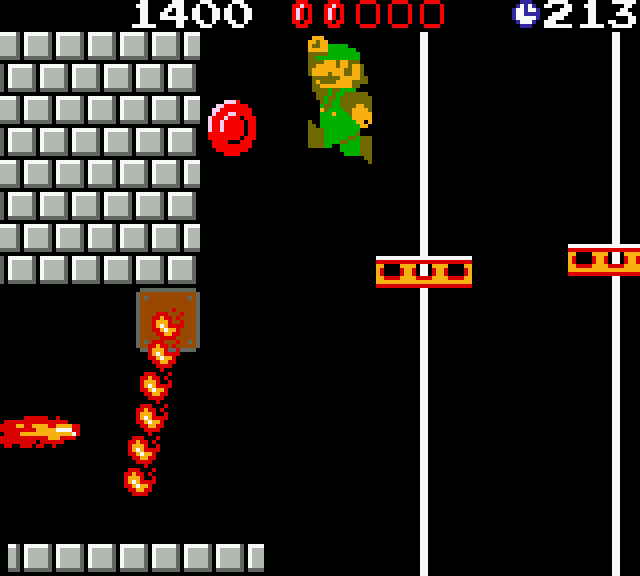
The Yoshi egg e’en makes use o’ the otherwise useless firebar block without its firebar. 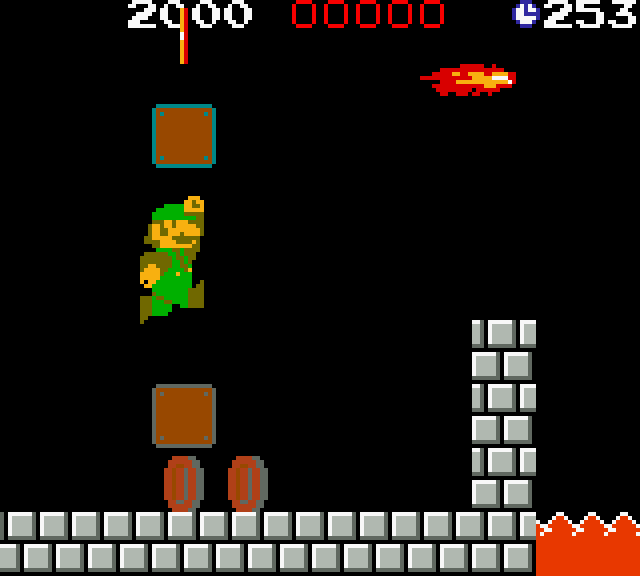
22. World 5-3
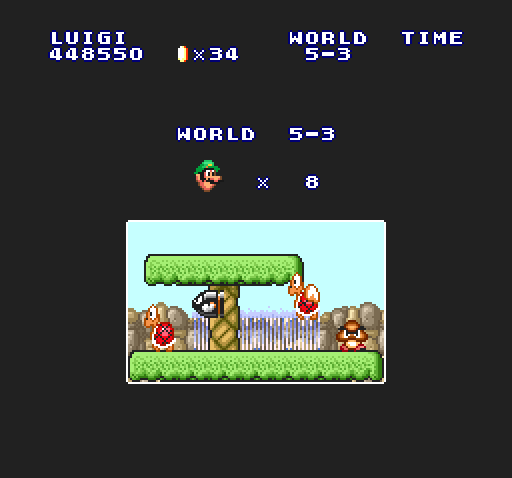
5-3 is just 1-3, but with randomly-generated Bullet Bills & slightly smaller elevator platforms. Unlike the Bullet Bills who shoot from cannons & actually have some strategy to them, these are basically just repainted flames from the castle levels that range from being ordinary obstacles you have to deal with e’ery so oft to obstacles that are way out o’ the way & feel pointless to, on thankfully rare occassions, unlucky situations where you’re struck while already in the midst o’ a jump & it’s too late to change course. Granted, you can avoid these by only jumping just after a Bullet Bill has passed, before it has time to come round ’gain; ¿but who wants to stop & go so oft? 1-3 doesn’t have this problem, since there’s no luck factor in it @ all. Despite this, the Bullet Bills don’t add ’nough extra challenge to make this level fit in with world 5 — certainly not after difficulty bumps like 5-1 & 5-2.
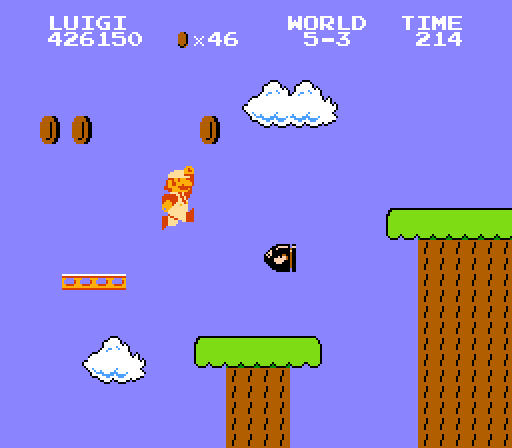
Since this level is so simple & since 1-3 used all the halfway interesting locations, 5-3’s red coin placements are laughably lame: ¡3 o’ them are just floating out in the open, all scrunched together in the middle!

The Yoshi Egg’s location is strikingly e’en worse than the already bad location in 1-3: 5-3’s is @ the end, past the staircase, which has nothing to do with the main level & is too easy to locate after using Yoshi’s egg finder ( ’cause it looks nothing like the rest o’ the level ). The whole point o’ the egg finder is that it challenges you to remember the level to remember where the small screen they show you is; but that’s trivial when it’s the flagpole screen.
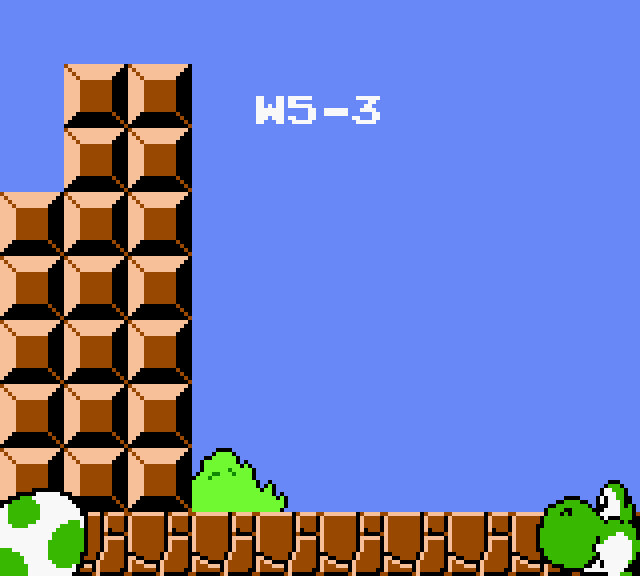
21. World 1-4
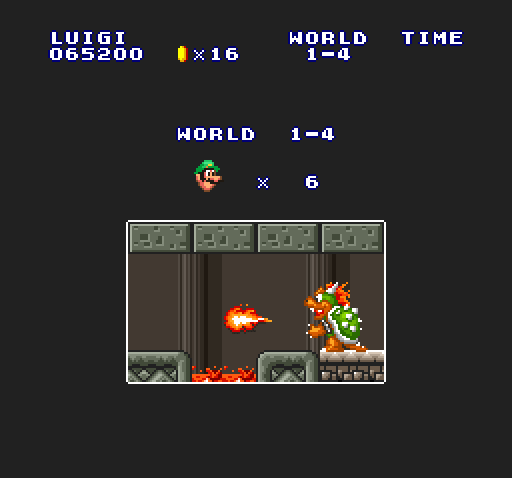
As you can imagine, the 1st castle level is the least challenging & complex castle level — tho I have to admit, having the firebar under the ?-block is a strong setpiece in which to introduce the firebars, & the arrangements near the middle, specially the 2 next to each other, forcing the player to weave round them, is also no slouch. 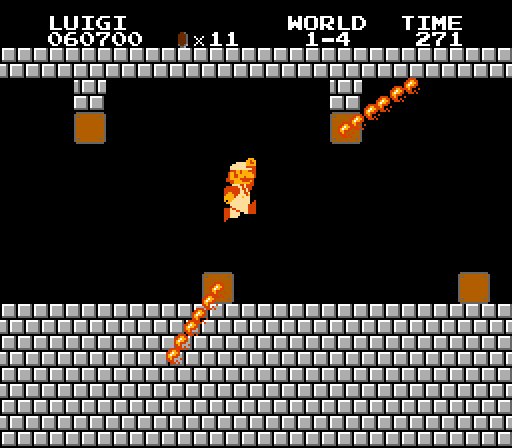
After this is a long passageway that looks dangerous, as it’s full o’ firebars, but you can usually just run thru with the firebars timed so that they’re out o’ the way when you reach them. Unlike later levels, this ease works much better in such an early level & does a great job o’ keeping such an early level exciting while still keeping it relatively easy. 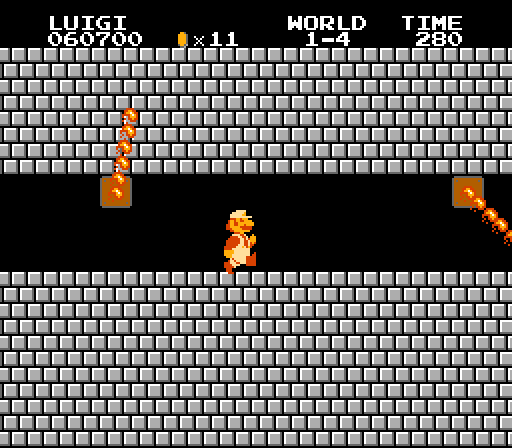
Less interesting is the big area full o’ hidden coin blocks, which I guess could, on rare occasions, cause some cheap bullshit hits if you bonk 1 while trying to dodge Bowser’s fire — but that’s hardly a good element to have in the 1st castle, or anywhere, truly. These are only useful otherwise in Super Mario Bros. Deluxe’s challenge mode, where 1 o’ them hides the Yoshi egg; ¿but on any other version, who’s going to waste their time jumping round like an idiot for up to 6 coins? 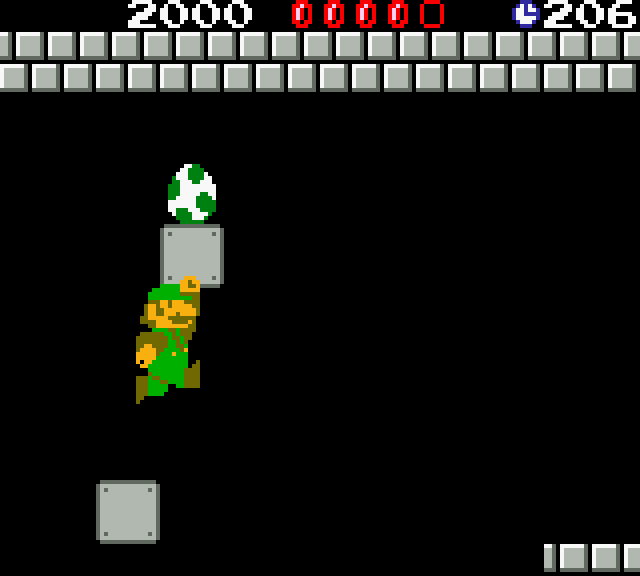
The red coin locations are all strong, tho, specially the ones right next to firebars, forcing you to run in & out to grab them before the firebar swoops back round to hit you. 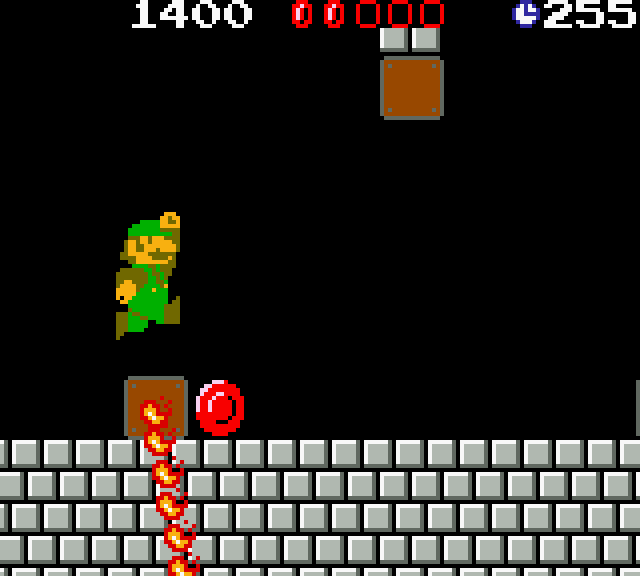
20. World 5-4
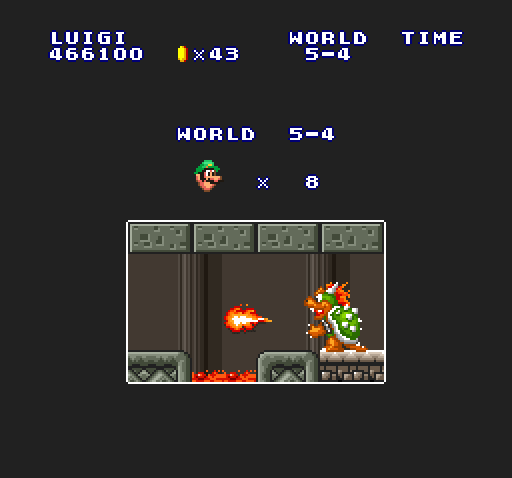
In contrast to 1-4 vs. 6-4, 5-4 is an improvement o’er its twin, 2-4. The 1st area is a combination o’ 1-4 & 2-4’s opening, but set up in a way that you can rush thru.
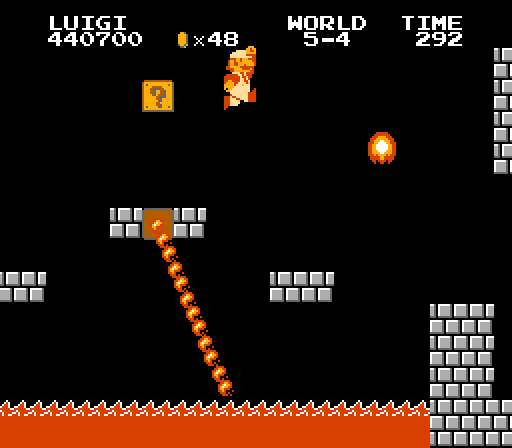
Similarly, while the 2nd hallways are mo’ challenging with mo’ firebars, you can still rush thru the bottom path without stopping with a well-timed duck jump.
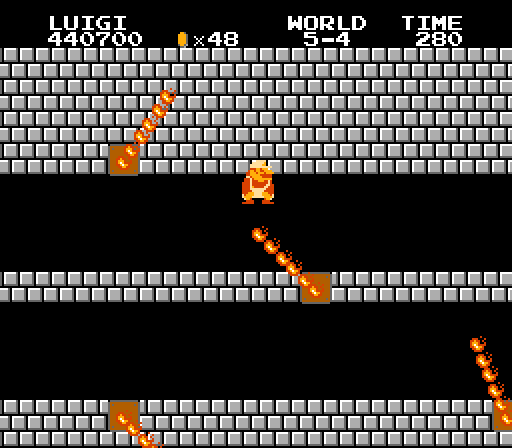
The arrangement that now has a firebar after the elevator section is a bit silly with the lower passage; — ¿why would anyone want to go under it for those 3 coins when there’s such a high chance o’ getting hit — but I do quite like the challenge dynamic wherein it can be quite a challenge to jump o’er or e’en just not run into if you let yourself fall into that area, but can be easy to clear with a long jump straight o’er that whole lower section — with the caveat that this might open you to getting hit by 1 o’ Bowser’s flames.
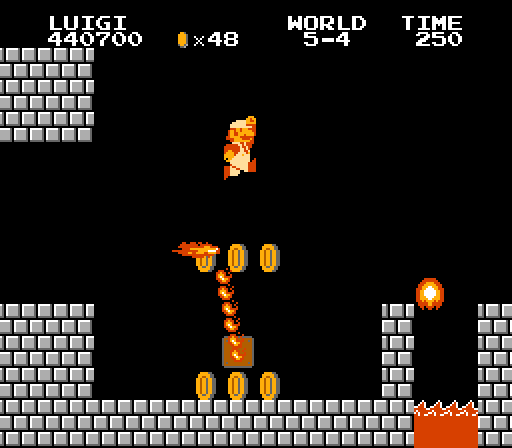
In fact, 5-4 may be the hardest castle in the game, strangely ’nough. It’s certainly harder than the jokes that are 6-4 & 7-4. That said, it’s still just a minorly improved copy-pasta o’ an already not-very-good level, & it’s certainly not the most interesting castle level.
Unlike 2-4, this level is rude ’nough to force you to take the top path to get a red coin… which is the easiest path, so you want to take it, anyway.
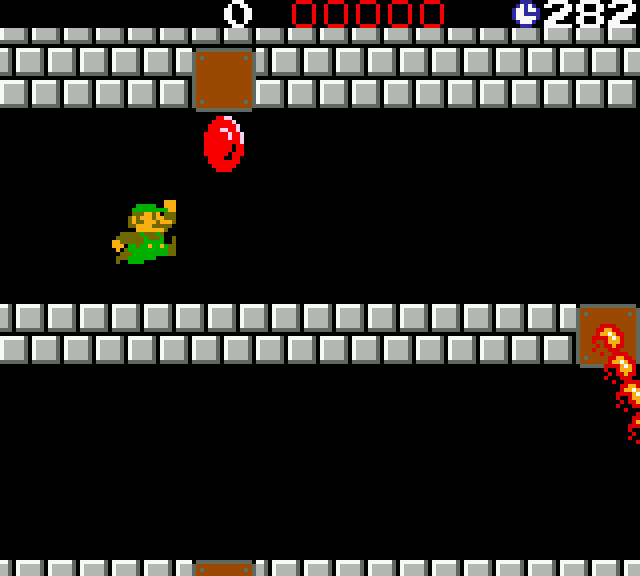
I do prefer the last 2 red coins, tho — specially the way you have to actually dig for the red coin ’mong all the bricks while dodging Bowser’s attacks, rather than just having the red coin be awkwardly next to the bricks. I like how they add the extra challenge by making you slide under the firebar going toward you for the 4th coin.
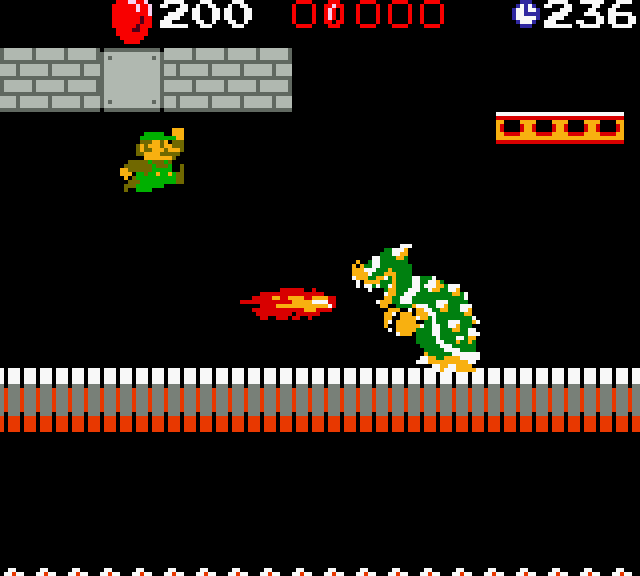
The Yoshi Egg location is just dumb & arbitrary, howe’er & is right next to the 4th red coin, to boot, but doesn’t e’en take advantage o’ its danger. ¿Wouldn’t it be mo’ interesting if you had to hit & jump on the hidden ?-block ’bove this firebar block in 2-4, but with the firebar now there? I would’ve forgiven them for having the Yoshi Egg in the same place in both levels — it would’ve felt like a clever twist.
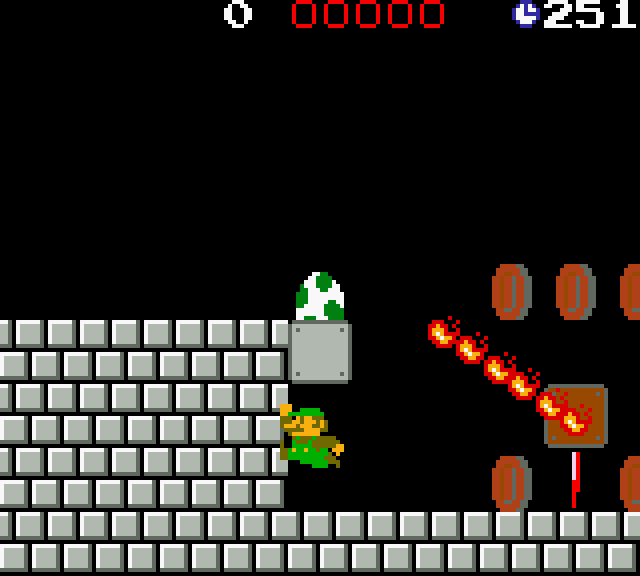
19. World 1-3
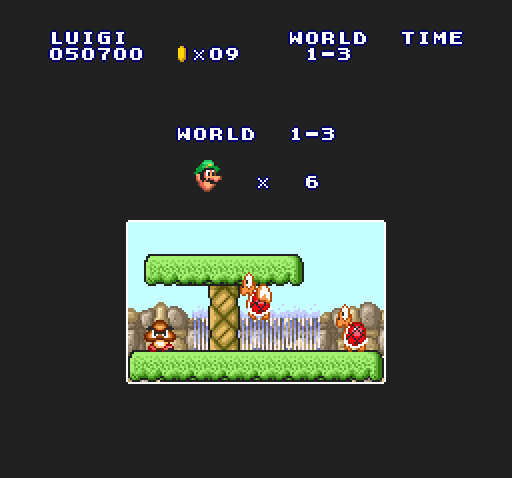
1-3 falls into that awkward middle o’ not being the kind o’ memorable introductions as 1-1 & 1-2, or e’en 1-4 after it, nor being as complex or intricate as later levels. With all the pits, it almost feels too difficult for how early it is, specially compared to the easier castle level after it, but not much mo’ difficult that it’s as striking as other palm-tree levels. The most interesting thing, other than its introduction o’ its fresh bright green hills tileset so soon after introducing the world to the normal o’erworld & underground tilesets, is the different staircase @ the end; & e’en then, it doesn’t serve much o’ a difference in terms o’ gameplay. 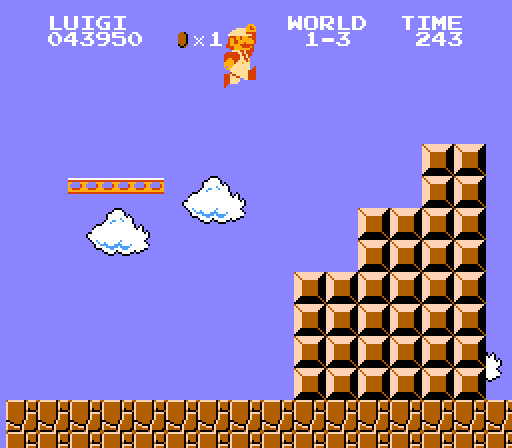
There are a few interesting setpieces, like the 3 times you jump up a high cliff guarded by a Goomba or Red Koopa, & to some extent they have multiple paths, such as the top & bottom palm trees near the middle. 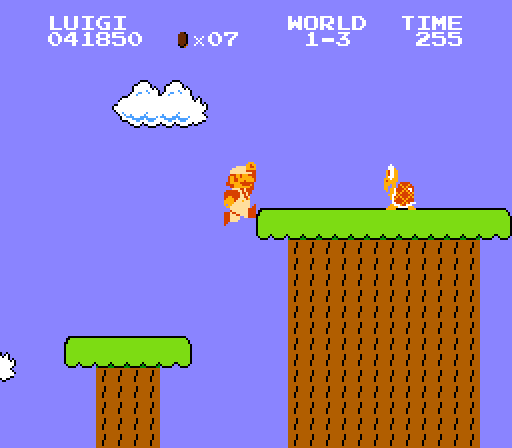
There are also side areas, like the top palm tree with 4 coins & a Red Koopa & the lower area under the flying Red Paratroopa near the end, which could also serve as a safety net — tho why it’d be important to have 1 after plenty o’ unguarded pits is a mystery. ’Twas a smart decision to add the secret mechanic wherein you need to collect all the coins in the 3rd level o’ a world to unlock the hidden 1-up in the next world, as the need to collect coins is the only use for many o’ these side areas, tho the way they integrated this mechanic in such an obscure manner that would make few actually bother to do so feels awkward & is an example o’ how Super Mario Bros. was platformers still naively trying to find their footing leaving the arcade world & entering mo’ in-depth console gameplay. 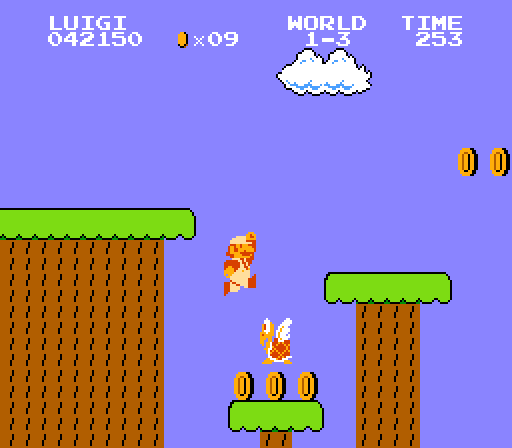
Some o’ the elements feel forced or thrown in, tho. ¿Why is the 1st elevator moving up & down there? It doesn’t fit with the level theme & doesn’t accomplish anything, since you could reach the top hill without it & certainly the bottom hill without it. 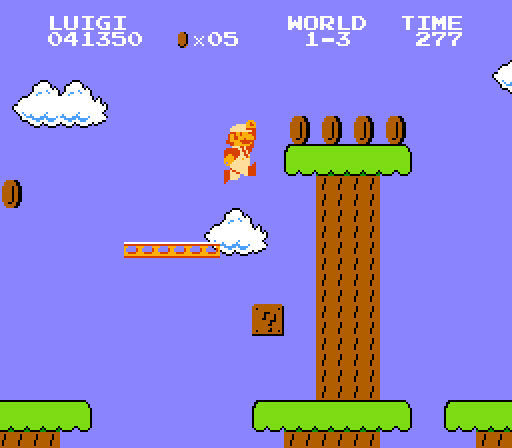
The red coins do serve as a way to legitimize some o’ the aforementioned frivolous setpieces, like the high cliff near the beginning, the low cliff near the end, & the 1st elevator. 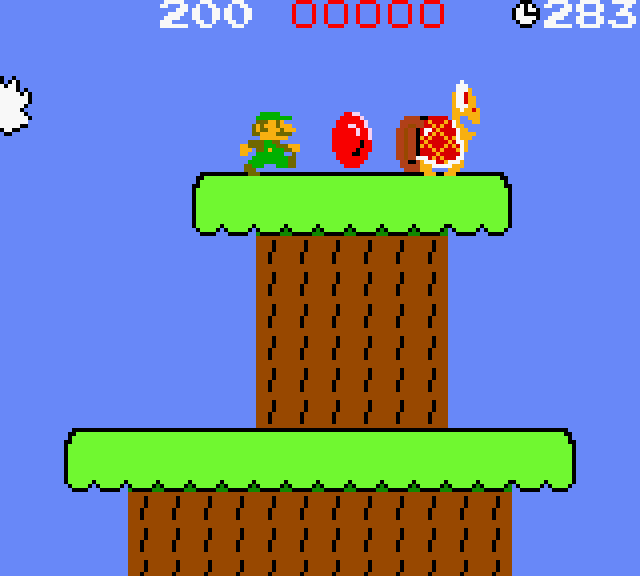
The Yoshi Egg’s in a nondescript place, tho — so nondescript the developers felt the need to add an extra cloud background ’hind it to make it stand out mo’. 
18. World 3-2
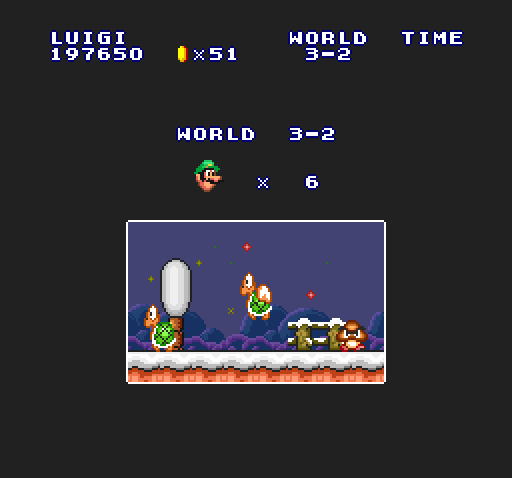
3-2 is a striking step down in complexity & variety, not only compared to its immediate predecessor, but also to possibly e’ery other non-castle level, being mainly flat ground with long lines o’ Koopas & Goombas. On the other hand, this level trades that lack o’ variety for a greater level o’ thematic coherence, focusing so tightly on what we might later call the “gimmick” o’ kicking Koopas @ other enemies. It’s obviously not the 1st time the game gives you the opportunity to do so, but this is the 1st level that practically screams @ you to do so with its straight lines o’ enemies. While 3-1 gives you a tricky opportunity to nab a rare 1-up thru hitting 8 enemies in a row with a Koopa shell, this level introduces this properly with the 1st line o’ enemies, with just the right # o’ enemies to get a 1-up @ the end, making it stupidly easy to get the 1-up — tho also easy to lose it ’gain after the shell ricochets off the block just after the last Koopa. Considering they repeat this setup almost verbatim in 5-1, it’s surprising they don’t make this version easier by putting a pit @ the end. 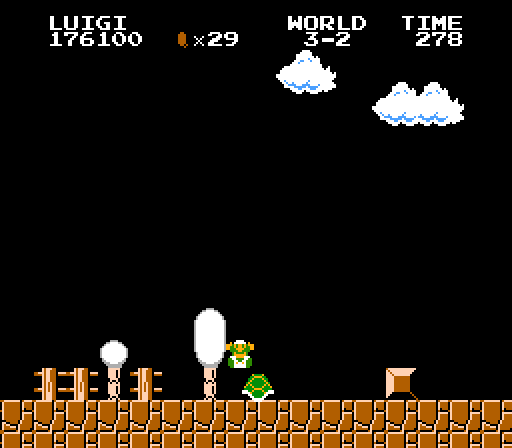
This level is perfectly inconsistent ’bout where it gives players the opportunity to rack up extra lives. Just after the 1st opportunity, the level seems to offer ’nother opportunity right after, with a Koopa followed by 2 Goombas, but then pulls the rug out from under the player by having a wall early. They follow this with a Koopa in a tiny hole with an infinite-coin block not worth hitting, & then a hopping Paratroopa, who is also followed by too few enemies to win a 1-up from it, making taking the effort to clip its wings & kick its shell pointless, & then, when the level gets it into your head that kicking shells into enemies isn’t going to net you 1-ups anymo’, they twist this expectation & follow this with a section with a Koopa followed by 8 enemies, tho made e’en mo’ challenging than the hopping Paratroopa by putting the 1st Koopa so near the edge that the player has to speedrun to get there & kick it from the left in time — & e’en then it can be an awkward maneuver that leaves the player mo’ likely to get hurt. Finally, they follow this up with 1 mo’ section with a Koopa, followed by… not ’nough enemies to net a 1-up. All o’ these twists exhibit a perfect counterexample to the lazy mainstream view that all levels in all video games should follow a straight difficulty curve upward in regards to the evolution o’ setpiece challenges, but can, in fact, benefit from surprise ups & downs to keep players from getting bored. 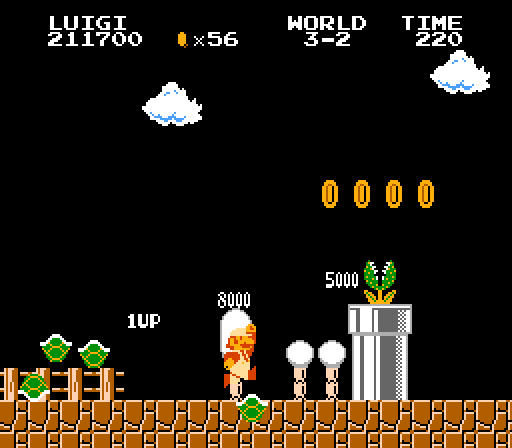
Still, this level is perhaps too obsessed with its theme — which, to be honest, isn’t all that interesting, & isn’t e’en unique to this level. There are many other levels with gimmicks just as good if not better that also do a better job o’ balancing these gimmicks with other elements for variety. E’en something as o’erused as a bonus underground room — e’en if ’twere just a copy o’ 1 from ’nother level — would’ve improved this level. A’least this level is brief ’nough that its focus doesn’t become tedious.
Unfortunately, such a simple level doesn’t provide a fertile ground for red coin locations: they’re mostly just thrown out in the open. Many are just high up, requiring you to jump up other blocks to reach them or make mightly leaps. the 1st is literally just right on the ground. 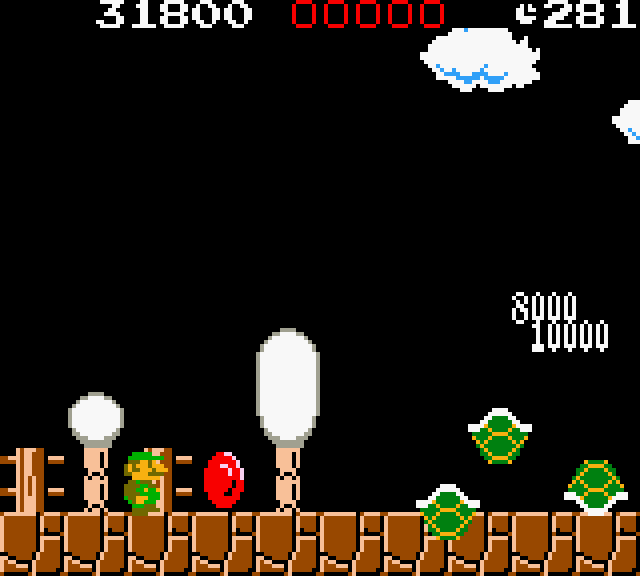
The Yoshi Egg’s location is stupid: it’s @ the top o’ a pyramid o’ hidden ?-blocks that weren’t there in the original version in an indistinct place. Worse, they put a red coin round there — which, now that I think ’bout it, a’least acts as a hint that these ?-blocks are here. 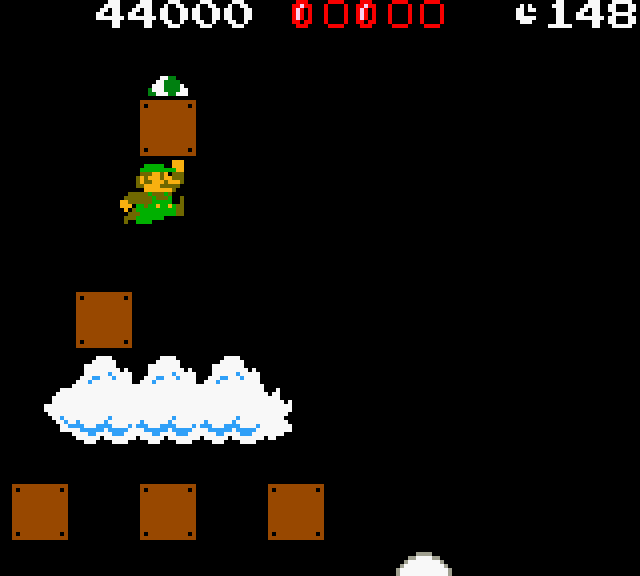
17. World 8-1
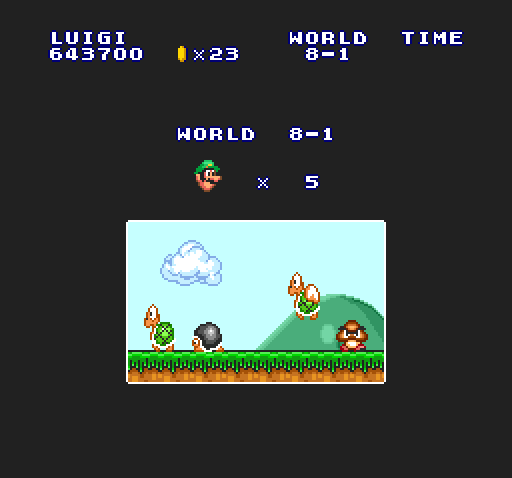
8-1 is a mixed bag: it has a few excellent, tricky sections that remind you why it starts the final world, such as the plot pockmarked with holes & swarming with Paratroopas, the staircase broken up with several holes ( which you’re likely to be rushing up, due to this level’s length & tight time limit ), & the infamous 1-block jump surrounded by long chasms you have to run-jump o’er without stopping on the single block. 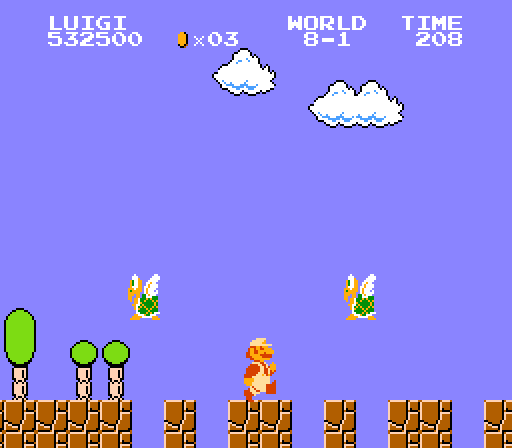
Howe’er, the designers felt the need to make this the longest level in the game, & filled most o’ that length with what feels like padding, just long lengths o’ basic enemies you’ve dispatched with ease many times before, oft with a shell you can kick to dispatch them all in 1 swoop, with just the need to jump o’er the shell when it ricochets back, as if you haven’t already done that many times mo’ than half the game ago. 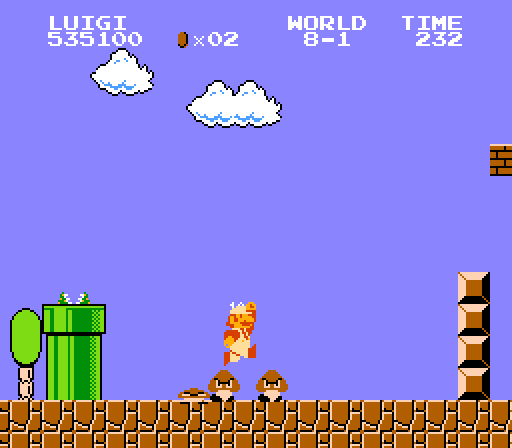
Some sections, like the Koopa ’tween the 2 walls, where you’ll ne’er have any reason to go, are just baffling. 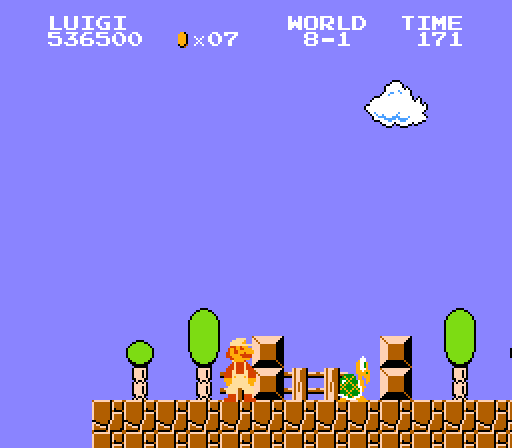
The red coin locations are all great, tho, & take advantage o’ notable setpieces for challenges, such as putting 1 ’bove 1 o’ the many potholes in 1 section or in the easy-to-miss multicoin brick round the middle. 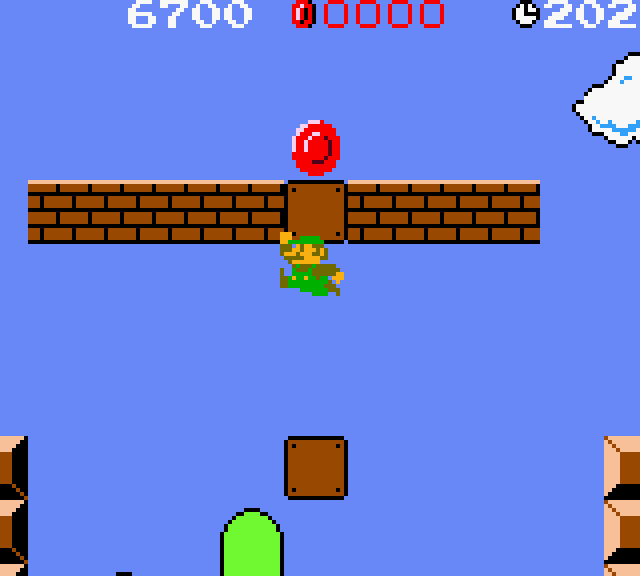
They e’en make the small pit with the Koopa walking back & forth less useless by putting a red coin there, giving players a reason to go in there. 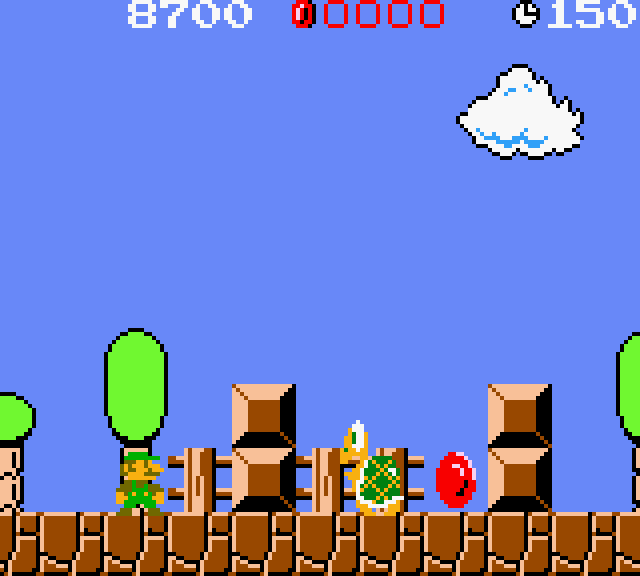
The Yoshi Egg is also in the perfect place, the most memorable place in the whole level: right on that single block surrounded by vast chasms. 